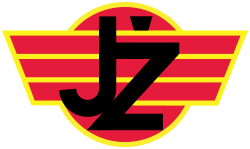Yugoslav Railways
 | |
| Company type | Government-owned |
|---|---|
| Industry | Railway transport, logistics and shipping |
| Predecessor | |
| Founded | 11 November 1918 |
| Defunct | 4 March 1992 |
| Fate | Breakup of Yugoslavia |
| Successor |
|
| Headquarters | , |
Area served | Yugoslavia |
| Products | Rail transport, rail infrastructure, cargo transport, services |
| Owner | Government of Socialist Federal Republic of Yugoslavia (100%) |
Yugoslav Railways (Template:Lang-sh, Југословенске железнице; Template:Lang-mk; Template:Lang-sl), with standard acronym JŽ (ЈЖ in Cyrillic), was the state railway company of Yugoslavia, operational from the 1920s to the 1990s.
History

The company was first founded as the National Railways of the Kingdom of the Serbs, Croats and Slovenes by incorporating the already existing railroad companies. In 1929, it was renamed along with the country to Yugoslav State Railways (JDŽ). In 1941 the railway ceased to exist and two new railway companies were created: Croatian State Railways (HDŽ) and Serbian State Railways (SDŽ). The railway was reestablished after World War II. In 1952 it was renamed to Yugoslav Railways.
It ceased to exist after the breakup of Yugoslavia in the 1990s. Several successor companies were formed from the assets of the railway:
- Željeznica Crne Gore (ŽCG) - Montenegro
- Hrvatske željeznice (HŽ) - Croatia
- Željeznice Federacije Bosne i Hercegovine (ŽFBiH) - Federation of Bosnia and Herzegovina, Bosnia and Herzegovina
- Željeznice Republike Srpske (ŽRS) - Republika Srpska, Bosnia and Herzegovina
- Makedonski Železnici (MŽ) - Macedonia
- Slovenske železnice (SŽ) Slovenia
- Železnice Srbije (ŽS) - Serbia
- Hekurudhat e Kosovës - Kosovo
Yugoslav Railwaymen's Day
Yugoslav Railwaymen's Day was established in 1950 to remember the work and sacrifice of railwaymen and women across Yugoslavia. It was founded on the 30th anniversary of the general railway strike of 1920, which begun on 15/16 April and lasted for the rest of that month. During that time all railway traffic across Yugoslavia was suspended, with railway workers from all railway stations, furnaces and workshops rose up against the o. At it’s peak, the violence resulted in 14 killed on Zaloška cesta in Ljubljana. Working people on the Yugoslav railways celebrated this day solemnly and laboriously, recalling the many events of the growth and maturation of the workers' movement and everything that led to the historic general strike. It was celebrated annually from its inspection in 1950 until 1991.
Rolling stock
In its beginnings, the JŽ was using mostly Austrian and Hungarian-made steam locomotives.[citation needed] Electric and diesel locomotives were introduced in number from the 1960s onwards; electric locomotives were acquired from Ansaldo (Italy); Alsthom, ASEA also supplied some classes, and locomotives were also license built in Croatia and at Electroputere in Romania; in the 1980s the indigenous AC electric JŽ series 442 was developed by Rade Končar.[1]
Most of the mainline diesel locomotives were from GM-EMD with a substantial number of Brissonneau et Lotz designs (some license built by Đuro Đaković). Shunters were acquired from MAVAG, and Jenbacher werke, and also license built by Đuro Đaković. The railway also operated locomotives from the Lyudinov works, Soviet Union, ex-DB V60 shunters (Germany) and high power Krauss-Maffei ML 2200 C'C' type.[1]
Railcars, EMUs, and DMUs were sourced from Spain, Italy, Hungary, Germany and Soviet Union from a variety of manufacturers.[1]
Classification system
A new numbering system was tried for the new standard locomotives built from 1930. All locomotives were renumbered by 1935, which was valid for steam engines.
The locomotives on the 760 mm (2 ft 5+15⁄16 in) Bosnian gauge were classified 70-98 and for the 600 mm (1 ft 11+5⁄8 in) gauge 99.2, 99.3 and 99.4.[2]
A three plus three digit class designation system was used from the late 1950s - the first digit indicated the power type of vehicle: 3 indicated a 3 kV DC locomotive; 4, a 25 kV AC loco; 6 diesel electric; 7 diesel hydraulic; 8 diesel mechanical and 9 an infrastructure or works vehicle. The second digit indicated the vehicles gauge and axle arrangement: 0, a narrow gauge railcar; 1, a standard gauge railcar; numbers 2 to 6 indicated a locomotive with that number of driving axles. The third digit indicated different classes within the type description. The fourth digit indicated class subtypes, and the last two digits the vehicle number (starting at 01).[1]
Locomotives and railcar classes
Carriages
Both carriages from the former Yugoslav Railways as well as second-hand carriages from all over Europe are available, however many of them not in operating condition. At the moment, all locomotive hauled passenger trains use former SJ coaches and, in the case of the InterCity, one carriage of Makedonski Železnici.
| Description | Image | Type | Number | Built | Builder | Notes |
|---|---|---|---|---|---|---|
| ÖBB-Spantenwagen | Former ÖBB Spantenwagen
Acquired around 1984. At least one seen 50 72 24-20 650-2 | |||||
| Built in Yugoslavia. One seen with UIC 50 72 24-25 508-7 |
References
- ^ a b c d Theo Stolz; Christophe Stolz (eds.), "Die Aufteilung des JŽ-Triebfahrzeugparkes", www.le-rail.ch (in German)
- ^ Halliwell, C.J. (1973). The Locomotives of Jugoslavia. Malmö, Sweden: Frank Stenvalls Förlag. pp. 13–14. ISBN 91-7266-012-0.
External links
- Frank Válóczy (ed.), Railways of the former Yugoslavia, archived from the original on 26 October 2009
- Winchester, Clarence, ed. (1936), "In central Europe", Railway Wonders of the World, pp. 1454–1463 illustrated description of the railways of Yugoslavia in the 1930s.
